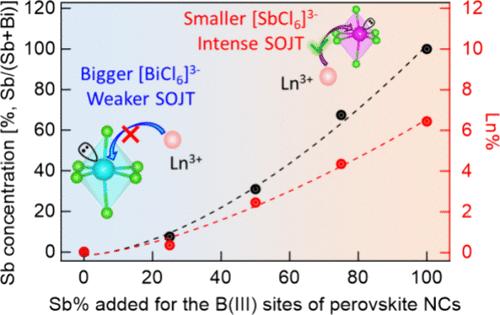Tailoring Substitutional Sites for Efficient Lanthanide Doping in Lead-Free Perovskite Nanocrystals with Enhanced Near-Infrared Photoluminescence
IF 16
1区 材料科学
Q1 CHEMISTRY, MULTIDISCIPLINARY
引用次数: 0
Abstract
The incorporation of rare earth lanthanide ions (Ln3+) into lead-free halide perovskite nanocrystals (NCs) is an effective and promising strategy to expand their optical, magnetic, and electrochemical properties. Herein, we designed and synthesized various Ln3+ (including Yb3+, Er3+, and Nd3+), doped Sb3+- or Bi3+-based and Sb3+/Bi3+ alloyed lead-free perovskite NCs, including vacancy-induced perovskite (A3B(III)2X9), double perovskite (A2B(I)B (III)X6), and layered-double perovskite (A4B(II)B(III)2X12) NCs with different energy transfer pathways to study the Ln3+ dopant photoluminescence (PL). While a small size mismatch between dopant ions and host substitutional sites are critical for efficient doping of many first-row transitional metal ion doped metal chalcogenides, surprisingly, the Ln3+ ions, including the large Nd3+ ions (112 pm), prefer smaller isovalent Sb(III) octahedral (Oh) sites (90 pm) instead of Bi(III) Oh sites (117 pm) in these lead-free perovskite NCs. Significantly, similar substitutional site-dependent Ln3+ doping efficiencies were obtained across all three different perovskite host lattices, despite differences in host-to-dopant energy transfer mechanisms, which can provide strong evidence of the preferred Sb3+ substitutional sites for lanthanide dopants in these lead-free perovskite lattices. The efficient Ln3+ doping in Sb3+-rich perovskite NCs leads to enhanced Ln3+ ion PL of the doped NCs. The preference of smaller Sb (III) over Bi(III) substitutional sites for Ln3+ dopants is attributed to the relatively high polarizabilities of lanthanide ions and the smaller cationic sites inside [SbX6]3– compared with [BiX6]3– octahedra. This study provides a fundamental understanding of Ln3+ doping behavior in lead-free perovskite NCs and opportunities for designing efficient Ln3+-doped functional materials by tuning the microenvironment of the host lattice for enhanced properties.

在具有增强近红外光致发光功能的无铅过氧化物纳米晶体中定制掺杂镧系元素的取代位点
稀土镧系离子(Ln3+)掺入无铅卤化物钙钛矿纳米晶体(NCs)是一种有效且有前途的策略,以扩大其光学,磁性和电化学性能。本文设计并合成了多种Ln3+(包括Yb3+、Er3+和Nd3+)、掺杂Sb3+或Bi3+基和Sb3+/Bi3+合金的无铅钙钛矿NCs,包括具有不同能量传递途径的空位诱导钙钛矿(A3B(III)2X9)、双钙钛矿(A2B(I)B (III)X6)和层状双钙钛矿(A4B(II)B(III)2X12) NCs,以研究Ln3+掺杂剂的光致发光(PL)。虽然掺杂离子和宿主取代位之间的小尺寸失配对于许多第一排过渡金属离子掺杂金属硫族化物的有效掺杂至关重要,但令人惊讶的是,在这些无铅钙钛矿NCs中,Ln3+离子,包括大Nd3+离子(112 pm),更倾向于较小的同价Sb(III)八面体(Oh)位点(90 pm)而不是Bi(III) Oh位点(117 pm)。值得注意的是,尽管宿主到掺杂物的能量转移机制存在差异,但在所有三种钙钛矿主体晶格中都获得了相似的取代位依赖的Ln3+掺杂效率,这可以为这些无铅钙钛矿晶格中镧系掺杂物的首选Sb3+取代位提供有力证据。在富Sb3+钙钛矿纳米碳管中高效掺杂Ln3+,导致掺杂纳米碳管的Ln3+离子PL增强。与[BiX6]3 -八面体相比,较小的Sb (III)比Bi(III)更倾向于取代Ln3+掺杂剂,这是由于镧系离子的极性相对较高,并且[SbX6]3 -内的阳离子位置较小。该研究为无铅钙钛矿纳米材料中Ln3+掺杂行为提供了基本的理解,并为通过调整主晶格微环境以增强性能来设计高效的Ln3+掺杂功能材料提供了机会。
本文章由计算机程序翻译,如有差异,请以英文原文为准。
求助全文
约1分钟内获得全文
求助全文
来源期刊

ACS Nano
工程技术-材料科学:综合
CiteScore
26.00
自引率
4.10%
发文量
1627
审稿时长
1.7 months
期刊介绍:
ACS Nano, published monthly, serves as an international forum for comprehensive articles on nanoscience and nanotechnology research at the intersections of chemistry, biology, materials science, physics, and engineering. The journal fosters communication among scientists in these communities, facilitating collaboration, new research opportunities, and advancements through discoveries. ACS Nano covers synthesis, assembly, characterization, theory, and simulation of nanostructures, nanobiotechnology, nanofabrication, methods and tools for nanoscience and nanotechnology, and self- and directed-assembly. Alongside original research articles, it offers thorough reviews, perspectives on cutting-edge research, and discussions envisioning the future of nanoscience and nanotechnology.
 求助内容:
求助内容: 应助结果提醒方式:
应助结果提醒方式:


